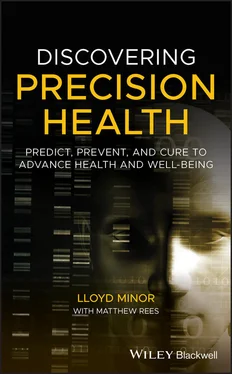Applying common measures for longitudinal assessment of physician well‐being and the primary drivers of well‐being.
Developing and testing innovative strategies to improve physician well‐being.
Meeting at regular intervals to share innovative best practices to improve physician well‐being.
Implementing evidence‐based/best‐practice strategies to improve physician well‐being.
We’re also seeing interest by leaders of the medical establishment. In the fall of 2018, Shanafelt and I were among the authors of a Health Affairs blog posting that made the case for health systems to hire a chief wellness officer (CWO) to support the well‐being of clinicians [36]. The other coauthors included the president and CEO of the Association of American Medical Colleges, the presidents of the National Academy of Medicine and the American Nurses Association, and the CEO of the Accreditation Council of Graduate Medical Education. The role of a CWO is to help lead all aspects of organizational change necessary to reduce burnout and cultivate professional fulfillment. The CWO is a senior leader who plays a role analogous to that of the chief medical officer or chief quality officer. The key responsibilities of the CWO include evaluating the scope of the problem within the organization, reporting the results to senior leaders (e.g., the hospital board, dean, department chairs, operational leaders), developing an organization‐wide strategy to drive improvement, and overseeing broad system‐level efforts to make progress in the dimensions most relevant to the local organization.
Once again, these efforts primarily focus on system‐level improvements addressing dimensions of organizational culture and inefficiency in the practice environment. CWOs should also have expertise in tactics and strategies to support local unit‐level efforts to address unit‐specific issues. They must be effective in engaging other leaders (chief quality officer, chief medical officer, chief medical information officer, and human resources officer), partnering with them to drive necessary change and measuring the progress.
While change comes slowly in medicine and health care, as I will explain in more detail later, I am encouraged by the speed with which this issue has become a priority for many individuals and institutions. A lot more still needs to happen, and when it does, physicians and their patients will see the benefits.
* * *
One incontrovertible fact applies to U.S. health and the U.S. health care system: there’s a clear need for improvements to both. Declining life expectancy, coupled with large life‐expectancy gaps based on geography and income, is a tragedy at a moment when there are extraordinary new tools to enable healthy living. Similarly, the multiple flaws embedded in the U.S. health care system are imposing great costs on the United States—in outright spending (with low returns on that spending) and the care and treatment of patients.
I am confident that changes inspired by Precision Health approaches could help reverse the gloomy state of affairs I’ve just described. But first, I will explore the determinants of health that are largely overlooked by the U.S. health care system.
CHAPTER 2 THERE’S MORE TO “HEALTH” THAN HEALTH CARE
One of the essential ideas underpinning Precision Health is that medical care plays only a small role in determining our health outcomes. For too long, “health” has been equated with the amount and quality of medical care that’s delivered. Doctors have focused their work primarily on treating disease. That’s how they’ve been trained, how they’ve practiced, and how they’ve thought for as long as the medical profession has existed. The gold standard of medicine has always been to find treatments that work for large numbers of people and match them appropriately to the conditions facing their patients.
But this is an incomplete and flawed approach, in a few different ways. It’s reactive—it focuses on people only after they’re sick. More fundamentally, it doesn’t take account of the factors outside medical care and genetics that drive human health. While every individual is different, the key areas below show approximations of what are typically the key drivers of health outcomes, and the importance of each one relative to the others:
Environmental and social factors: 40 percent
Behavioral factors: 30 percent
Genetics and biology: 20 percent
Clinical care: 10 percent
The relative weighting of these categories is likely to change as our knowledge of human genetics and biology increases and as we can translate this knowledge into more effective approaches to prediction and prevention. As discussed in the vignette at the beginning of the introduction, more‐precise tests that screen for risk factors and enable diagnosis of disease at a much earlier stage are on the way. Although the specific percentages for each area vary among studies [1], the categories are not isolated—they clearly interact with each other. We know, for example, that the environment in which a person lives can have a profound influence on individual behavior. In the United States, for example, obesity [2] and the use of tobacco [3] tend to be more concentrated among people with low incomes. But the universal conclusion from all studies that have addressed this topic is that social, environmental, and behavioral factors are highly significant determinants of health. Recently, Robert M. Kaplan and Arnold Milstein, both of Stanford, reviewed the contributions of medical care to health outcomes, drawing on the conclusions reached in four major studies. They stated, “Healthcare has modest effects on the extension of U.S. life expectancy, while behavioral and social determinants may have larger effects” [4].
There are many reasons why behavioral and social determinants have received far less attention, particularly in the community of academic medicine, compared with genetics and medical care. These reasons include cultural expectations (physicians being identified with the treatment rather than the prevention of disease), perverse incentives in payment systems (reimbursements for care delivered and procedures performed that are not necessarily linked to outcomes), and the sheer complexity of these factors. The net effect has been a relative paucity of studies and actionable changes in social, environmental, and behavioral determinants.
But the future, as I will describe in the pages that follow, offers tremendous opportunities to transform health by moving from reactive medical care to proactive health care. We are living amid a biomedical revolution. Our understanding of the mechanisms of disease is growing in ways that enable us to prevent diseases altogether or diagnose them, and therefore treat them, much earlier and more effectively. New technologies applied to the monitoring of health will play an important role. Finally, the engagement of each of us in our health and well‐being, enabled by the information we have about our health, can be transformative.
PRECISION HEALTH AND POPULATION HEALTH
This chapter highlights some population‐level health challenges, such as obesity and poor nutrition. The wide‐ranging remedies that are typically utilized to help meet such broad challenges contrast with the Precision Health approaches, which are tailored to specific individuals. But the two are not in conflict. In fact, they can complement each other, thanks to the explosion of data generated from sources such as wearable devices, electronic health records, insurance claims, and clinical trials. These data, when coupled with the technology to manage and analyze them, make it possible to target emerging diseases with precise interventions at the level of the individual and at the level of the population as a whole. For example, as we further explore the roles of diet and exercise in preventing cardiovascular disease and cancer, we are likely to discover optimal combinations of certain behaviors for certain genotypes and phenotypes, leading to precise approaches to prevention rather than the one‐size‐fits‐all public guidance that has long characterized our approach.
Читать дальше












